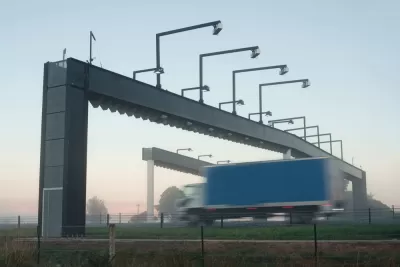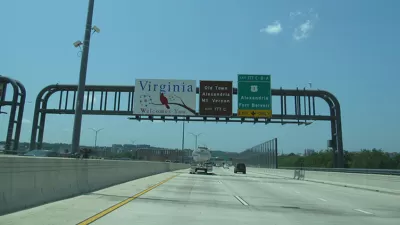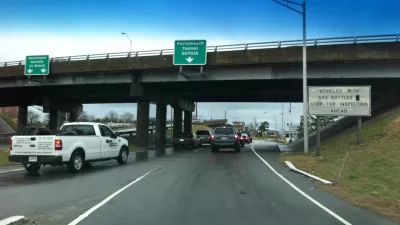Elizabeth River Tunnels, a complex project involving a new tunnel, rehabilitating two existing tunnels, and extending an expressway, is financed by a public-private partnership that includes tolls that Gov. Terry McAuliffe (D) called "exorbitant."

Historically, federal and state governments could afford the costs to maintain, rebuild, and expand road infrastructure. But with the federal gas tax and many state gas taxes unchanged for decades, state departments of transportation have been looking at the private sector for assistance. "But is there a downside for taxpayers?" asks the introduction to a PBS NewsHour Weekend investigation.
"Unlike traditional infrastructure deals, the private partners can invest equity in the project, and by taking on the risk, they can earn lucrative returns," states NewsHour reporter Christopher Booker. They also take on considerable risk and significantly lower the costs of the project, in some cases, making it financially feasible for cash-strapped states.
The controversy around the Elizabeth River Tunnels (ERT) Project (see map and bullets below), part of the Virginia Department of Transportation (VDOT) Hampton Roads Tunnels and Bridges, surrounds the funding component, including how much motorists should pay in tolls. In fact, the application of tolls themselves are controversial, with a trial court ruling they were illegal, and the Virginia Supreme Court overturing that decision in 2013 to the relief of former Republican Gov. Bob McDonnell who backed the P3 funding arrangement in 2011.
This graphic of the construction overview of the ERT and accompanying descriptions illustrate the complexity of the project. Note that the bottom bullet combines two projects:

- A new Midtown Tunnel: Fabricated at Sparrows Point, MD and will be located under the Elizabeth River adjacent to the existing Midtown Tunnel.
- Martin Luther King Extension: Extending the MLK Freeway from London Boulevard to Interstate 264, with a partial interchange at High Street—providing more direct access between the tunnels and a shorter, direct route to the Downtown Tunnel.
- Downtown Tunnel & Midtown Tunnel Rehabilitation: Significant rehabilitation, safety improvements and maintenance to the existing Downtown and Midtown Tunnels, which are 60, 50 and 25 years old.
Credit: Elizabeth River Tunnels
In April 2012, VDOT formed a partnership with a consortium called Elizabeth River Crossings (ERC) composed of "Sweden-based Skanska (involved in Atlantic Yards) and Australian financier Macquarie, which has worked on many toll road projects covered by Planetizen and most recently, the new University of Colorado A Line commuter rail to Denver International Airport.
Virginia, under Gov. McDonnell, and ERC agreed that tolls would provide $310 million, or 15% of the $2 billion project, with off-peak tolls set at $1.59 and the peak rate at $1.84. "The original proposal called for a toll between two and three dollars," notes Booker.
The remainder would come from:
- $638 million in state bonds, plus $421 million in state funds (53%)
- $441 million loaned by the U.S. Department of Transportation (22%)
- Equity investment by Skanska and Macquarie of $200 million (10%)
Enter new Democratic Gov. Terry McAuliffe in January 2014. Later that year, McDonnell was convicted of public corruption charges stemming from receiving gifts from a Virginia businessman.
McAuliffe tells Booker, "Exorbitant tolls to the toll riders, to the taxpayers of the commonwealth, start immediately even before any capacity was created. Created such an uproar. So I cut the tolls in half. I had to buy down the tolls."
In other words, even more state funds go to ERC so motorists pay 75-cents to a dollar to use the tunnels during the construction phase. And this was the third time tolls had been reduced at a cost to taxpayers.
McAuliffe also "eliminated them entirely for the new expressway," adds Booker. "To reimburse ERC for the lost toll revenue, the state is expected to contribute close to $200 million."
For ERC's perspective, Richard Cavallaro, president of Skanska USA states,
The risk transfer in these jobs is gigantic. I mean, the state is getting a price certainty on schedule capital expenditure, operational expenditure, at a very early stage. [S]ometimes I’m not sure people really understand that risk transfer’s a big, big deal.
McAuliffe's position on reducing tolls on the Elizabeth River tunnels is somewhat reminiscent of one taken by Gov. Matt Bevin (R-Ky.) who signed a bill in April that prohibited charging tolls on the replacement for the Brent Spence Bridge over the Ohio River between Covington, Ky. and Cincinnati, Ohio to the chagrin of his Democratic predecessor, i.e., the politics are reversed. Like ERP, construction would involve a P3.
A contrary perspective on the role the Virginia P3 is taken by Washington Post reporter, Michael Laris in a post last November. He writes that "poor dealmaking by government officials eroded the promised public benefits, according to interviews and project documents."
However, a spokeswoman for Skanska "said the state wanted commuters to pay less," and that caused the state's contribution to be increased.
To answer the NewsHour's introductory question on P3s, "is there a downside for taxpayers?" it may come down to how state government views the role of user fees in financing road infrastructure. If governors feel the need to "buy down" toll rates to placate angry motorists, or eliminate them altogether as was done in Kentucky, taxpayers will indeed suffer.
FULL STORY: Should the private sector help rebuild American infrastructure?

Planetizen Federal Action Tracker
A weekly monitor of how Trump’s orders and actions are impacting planners and planning in America.

Maui's Vacation Rental Debate Turns Ugly
Verbal attacks, misinformation campaigns and fistfights plague a high-stakes debate to convert thousands of vacation rentals into long-term housing.

Restaurant Patios Were a Pandemic Win — Why Were They so Hard to Keep?
Social distancing requirements and changes in travel patterns prompted cities to pilot new uses for street and sidewalk space. Then it got complicated.

In California Battle of Housing vs. Environment, Housing Just Won
A new state law significantly limits the power of CEQA, an environmental review law that served as a powerful tool for blocking new development.

Boulder Eliminates Parking Minimums Citywide
Officials estimate the cost of building a single underground parking space at up to $100,000.

Orange County, Florida Adopts Largest US “Sprawl Repair” Code
The ‘Orange Code’ seeks to rectify decades of sprawl-inducing, car-oriented development.
Urban Design for Planners 1: Software Tools
This six-course series explores essential urban design concepts using open source software and equips planners with the tools they need to participate fully in the urban design process.
Planning for Universal Design
Learn the tools for implementing Universal Design in planning regulations.
Heyer Gruel & Associates PA
JM Goldson LLC
Custer County Colorado
City of Camden Redevelopment Agency
City of Astoria
Transportation Research & Education Center (TREC) at Portland State University
Jefferson Parish Government
Camden Redevelopment Agency
City of Claremont




























